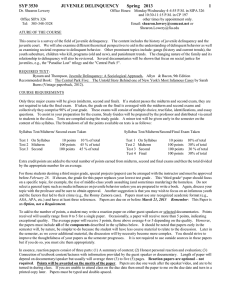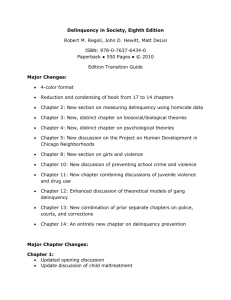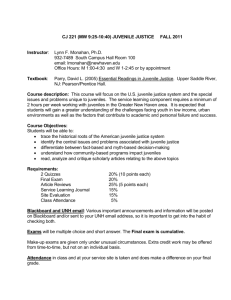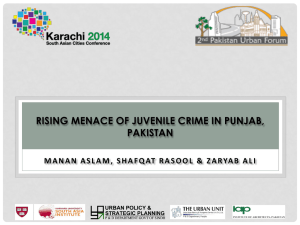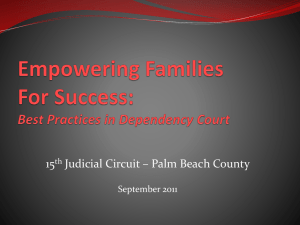SYP 3530 JUVENILE DELINQUENCY Spring 2015 1
advertisement
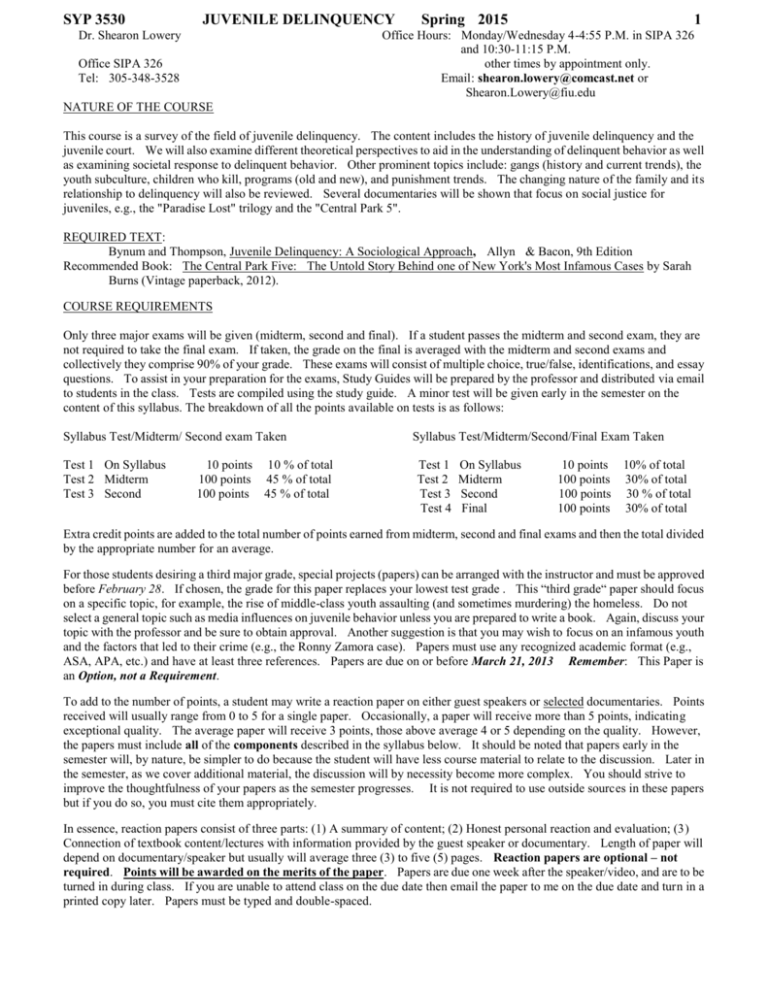
SYP 3530 JUVENILE DELINQUENCY Dr. Shearon Lowery Spring 2015 1 Office Hours: Monday/Wednesday 4-4:55 P.M. in SIPA 326 and 10:30-11:15 P.M. other times by appointment only. Email: shearon.lowery@comcast.net or Shearon.Lowery@fiu.edu Office SIPA 326 Tel: 305-348-3528 NATURE OF THE COURSE This course is a survey of the field of juvenile delinquency. The content includes the history of juvenile delinquency and the juvenile court. We will also examine different theoretical perspectives to aid in the understanding of delinquent behavior as well as examining societal response to delinquent behavior. Other prominent topics include: gangs (history and current trends), the youth subculture, children who kill, programs (old and new), and punishment trends. The changing nature of the family and its relationship to delinquency will also be reviewed. Several documentaries will be shown that focus on social justice for juveniles, e.g., the "Paradise Lost" trilogy and the "Central Park 5". REQUIRED TEXT: Bynum and Thompson, Juvenile Delinquency: A Sociological Approach, Allyn & Bacon, 9th Edition Recommended Book: The Central Park Five: The Untold Story Behind one of New York's Most Infamous Cases by Sarah Burns (Vintage paperback, 2012). COURSE REQUIREMENTS Only three major exams will be given (midterm, second and final). If a student passes the midterm and second exam, they are not required to take the final exam. If taken, the grade on the final is averaged with the midterm and second exams and collectively they comprise 90% of your grade. These exams will consist of multiple choice, true/false, identifications, and essay questions. To assist in your preparation for the exams, Study Guides will be prepared by the professor and distributed via email to students in the class. Tests are compiled using the study guide. A minor test will be given early in the semester on the content of this syllabus. The breakdown of all the points available on tests is as follows: Syllabus Test/Midterm/ Second exam Taken Test 1 On Syllabus Test 2 Midterm Test 3 Second 10 points 10 % of total 100 points 45 % of total 100 points 45 % of total Syllabus Test/Midterm/Second/Final Exam Taken Test 1 Test 2 Test 3 Test 4 On Syllabus Midterm Second Final 10 points 10% of total 100 points 30% of total 100 points 30 % of total 100 points 30% of total Extra credit points are added to the total number of points earned from midterm, second and final exams and then the total divided by the appropriate number for an average. For those students desiring a third major grade, special projects (papers) can be arranged with the instructor and must be approved before February 28. If chosen, the grade for this paper replaces your lowest test grade . This “third grade“ paper should focus on a specific topic, for example, the rise of middle-class youth assaulting (and sometimes murdering) the homeless. Do not select a general topic such as media influences on juvenile behavior unless you are prepared to write a book. Again, discuss your topic with the professor and be sure to obtain approval. Another suggestion is that you may wish to focus on an infamous youth and the factors that led to their crime (e.g., the Ronny Zamora case). Papers must use any recognized academic format (e.g., ASA, APA, etc.) and have at least three references. Papers are due on or before March 21, 2013 Remember: This Paper is an Option, not a Requirement. To add to the number of points, a student may write a reaction paper on either guest speakers or selected documentaries. Points received will usually range from 0 to 5 for a single paper. Occasionally, a paper will receive more than 5 points, indicating exceptional quality. The average paper will receive 3 points, those above average 4 or 5 depending on the quality. However, the papers must include all of the components described in the syllabus below. It should be noted that papers early in the semester will, by nature, be simpler to do because the student will have less course material to relate to the discussion. Later in the semester, as we cover additional material, the discussion will by necessity become more complex. You should strive to improve the thoughtfulness of your papers as the semester progresses. It is not required to use outside sources in these papers but if you do so, you must cite them appropriately. In essence, reaction papers consist of three parts: (1) A summary of content; (2) Honest personal reaction and evaluation; (3) Connection of textbook content/lectures with information provided by the guest speaker or documentary. Length of paper will depend on documentary/speaker but usually will average three (3) to five (5) pages. Reaction papers are optional – not required. Points will be awarded on the merits of the paper. Papers are due one week after the speaker/video, and are to be turned in during class. If you are unable to attend class on the due date then email the paper to me on the due date and turn in a printed copy later. Papers must be typed and double-spaced. SYP 3530 JUVENILE DELINQUENCY Spring 2015 2 Simply turning in “something” does not automatically add to a student’s grade. Maximum number of total reaction paper points shall not exceed 25. No papers will be accepted the last two (2) weeks of class. As these papers are done for extra credit, No late papers will be accepted. Do not plagiarize. If you are not familiar with FIU’s policy on plagiarism, please review it. Regular attendance is expected. However, please stay home when you are sick, especially when you have a contagious disease. In addition, should you encounter any other situation that interferes with class attendance on an extended basis, please inform the professor. If you attend class, you are expected to sign the attendance sheet circulated to document your presence; if you do not sign, officially you were not there. If you sign for another student, you risk academic penalties. In awarding course grades, extra consideration will be given for both exemplary attendance and constructive classroom participation as discussion of issues enhances understanding. Excessive absence may result in a lower grade. Some topics listed on this syllabus will require more class time than others. Therefore, be sure to follow the syllabus and read all required assignments. Since lecture time usually adds to the readings rather than just rehashing them, not all chapters will be discussed in class; students are, however, responsible for the material contained in all assigned chapters. In addition, students are encouraged to ask questions about the assigned reading either in class or during office hours. REMINDER: Be sure to read and understand FIU’s policy on plagiarism. GRADE SCALE A = 93-100 A- = 90-92 B+ = 87-89 B = 84-86 B- = 80–83 C+ = 77-79 C = 74-76 C- = 70-73 D+ = 67 - 69 D = 64 - 66 D- = 60 – 63 F = below 60 COURSE OUTLINE FOR JUVENILE DELINQUENCY A. B. C. Introduction 1. Overview of field 2. Delinquency across cultures a. The Mary Bell Case b. Robert Thompson and Jon Venables case c. Eric Smith case Required Reading: Chapters 1 and 2; class notes are also important Historical overview of juvenile delinquency in the United States A synopsis will be emailed to students. Sociological Explanations of Juvenile Delinquency 1. Social Strain Theories 2. Social Learning Explanations 3. Social Control Theories 4. Labeling Required Reading: Chapters 6, 7, and 8 D. Biological Explanations of Juvenile Delinquency 1. The search for the biological connection 2. Genetic Crime Causation: The XYY Hypothesis 3. Diet and Delinquency 4. Brain malfunctions 5. Nature vs. Nurture controversy Required Reading: Chapter 4 E. Psychogenic Explanations of Juvenile Delinquency 1. Psychoanalysis 2. Delinquent acts as symptoms 3. Adolescent Identity Crisis 4. Insufficient Moral Development Required Reading: Chapter 5 MID-TERM EXAM (To be announces two (2) weeks in advance) F. Dimensions of Delinquency Problems 1. Official sources of delinquency data 2. Unofficial sources of delinquency data Required Reading Chapter 3 SYP 3530 G. H. JUVENILE DELINQUENCY The Family and Juvenile Delinquency 1. The family as an agent of socialization 2. Working mothers and juvenile delinquency 3. Family size and birth order 4. Parental discipline 5. The changing nature of the family Required Reading: Chapter 10 Schools and Delinquency 1. Schools and the socialization process 2. Schools as “Combat Zones” 3. School Safety and “Zero Tolerance” Required Reading: Chapter 11 I. The Youth Subculture 1. Creation of a youth subculture 2. Distinctive elements of the youth subculture a. youth values b. dress grooming and fads c. mass media d. language 3. Youth hate groups 4. Influences of popular culture Required Reading: Chapter 12 J. Children Who Kill: Case Studies Class notes only K. Juvenile Gangs and Delinquent Behavior 1. Definition and history 2. Types of gangs 3. Composition of gang membership Required Reading: Chapter 13 L. Justice for Juveniles? 1. Police Discretion in handling juveniles 2. Juvenile Court 3. Juveniles remanded to adult court Required Reading: Chapters 14 and 15 M. N. O. Juvenile Corrections Required Reading: Chapter 16. Treatment and Prevention Strategies 1. Early Intervention 2. Treatment Ideology Required Reading: Chapter 17. Rethinking the Delinquency Problem Required Reading: Chapter 18. SECOND EXAM FINAL EXAM Monday April 14 Date Determined by FIU Final Exam Schedule Spring 2015 3
